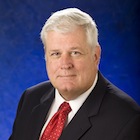
Baylor Health Care System and Temple-based Scott & White last week began their year-long due diligence to determine whether their systems are compatible.
The organizations announced in December their intent to merge to create the largest not-for-profit health system in the state and one of the largest in the nation.
In a joint telephone interview, Baylor chief executive officer Joel Allison and Scott & White chief executive officer Robert Pryor, MD, insisted the companies are a good fit.
The new entity will be called Baylor Scott & White, with more than 34,000 employees, 42 hospitals, more than 350 other patient-care settings and $6.7 billion in annual revenue. Allison will be CEO of the new company and Pryor will be the chief operating officer.
Pryor said, “We have a long history of working together. From the 50,000-foot level—and even the 25,000-foot level—we haven’t seen any snags. That’s really encouraging. We almost have the same strategic plan, mission and vision. Our cultures are entirely compatible and complementary.”
Unlike Baylor, Scott & White traditionally has been physician-led. Allison acknowledged that Baylor “is not exactly the same model, but we really engage physician leaders in population management and patient-centered medical homes.”

Allison said Baylor also has relied on physicians to take on leadership roles. He pointed to Baylor’s Best Care Committee (BCC), which determines the evidence-based protocols that will be spread quickly throughout the system.
The BCC acts as a sort of clinical legislature to align and drive quality initiatives. The group is led by the chief medical officer, chief nursing officer and the leading Physician Champion. The group considers new initiatives, shares results and best quality practices.
Baylor also has what it calls physician champions, who are not directly accountable to hospital management. They work with affiliated physicians to implement systemwide quality initiatives that have resulted in decreased mortality rates, more cost-effective and standardized care that emphasizes prevention.
Both CEOs noted their organizations were the only Texas systems that belong to the High Value Healthcare Collaborative, formed in 2010 by several high-profile integrated delivery systems to improve health care, lower costs and promote best practices.
Pryor pointed out Walmart selected Scott & White, along with Seattle’s Virginia Mason, Cleveland Clinic, Pennsylvania’s Geisinger Medical Center and Mercy Hospital Springfield (Mo.) to provide cardiac and spine treatments to the company’s employees with no co-payment or travel costs. Walmart said it selected those health systems because they showed they could produce high-quality outcomes for a negotiated bundled payment rate for specific procedures.
According to the Dartmouth Atlas of Health Care, Scott & White had the lowest Medicare per-capital inpatient costs between 2001 and 2005 among the nation’s 93 academic medical centers.
A Changing Landscape
Allison said Baylor historically had been reluctant to own a health plan, but the Affordable Care Act has “changed the landscape. Providers are going to have to take on more risk. The future models of care all point to clinical integration and cost effectiveness. This (merger) allows us to gain the intellectual capital (to run a health plan).”
Allison emphasized the need for greater efficiency because of future reimbursement cuts. He said due diligence would determine whether the combined systems would allow for economies of scale on supply purchases. He said the systems need to share best practices. Because the systems do not overlap geographically, no layoffs are anticipated. Allison said the systems initially will maintain separate headquarters.
Both CEOs said a merger will improve the combined system’s access to capital funding and minimize the need to acquire redundant medical technology.
“Whatever new widget comes along, we only have to buy one rather than two,” Pryor said.
Pryor said the systems have difference competencies that can be shared. He pointed to Baylor’s experience with joint venture hospitals. He said Scott & White has been a multi-hospital system for only six years.
“This (acquisition) was never about (gaining) market clout,” Pryor said.
Steve Jacob is editor of D Healthcare Daily and author of Health Care in 2020: Where Uncertain Reform, Bad Habits, Too Few Doctors and Skyrocketing Costs Are Taking Us. He can be reached at [email protected].






